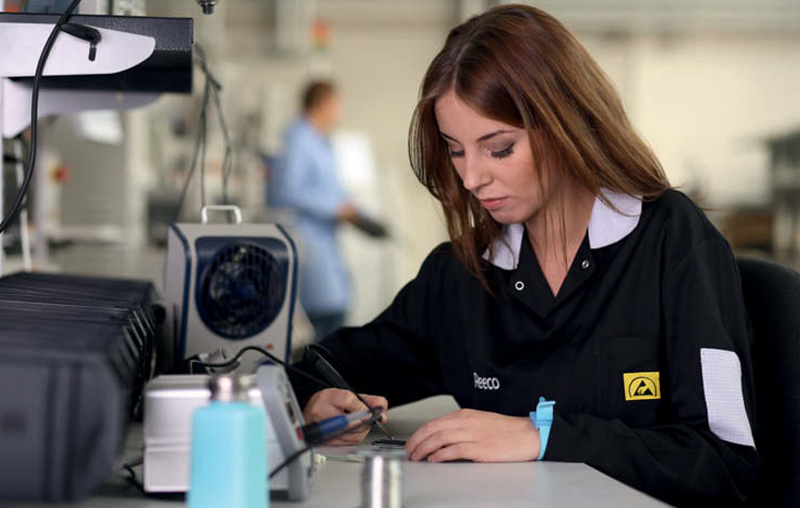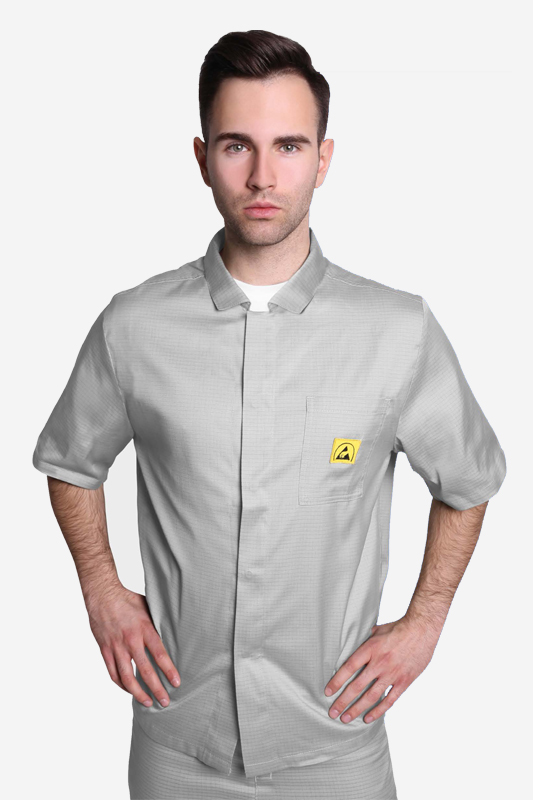Many companies involved in the production or service of electronic devices have implemented procedures for antistatic protection. Nevertheless, some of them still face problems caused by ESD damage to delicate and sensitive components. So what could cause the problems? There can be many places where static protection fails, but experience shows that it is often the result of using poorly chosen or poor quality clothing.
The need to wear anti-electrostatic clothes seems to be indisputable and this is where everyday work should start. Currently, in the electronics industry, it is difficult to find a company that does not maintain safety standards in this area, as informed employers do not wish to suffer losses due to obvious negligence.
Unfortunately, despite the good intentions and the provision of protective clothing for employees by those assigned to it, it very often turns out that these clothes do not fulfil their role. Threads that stick out of seams, badly made antistatic fabric, which loses its properties after a few washes, may become a threat affecting the quality of products. There are many cases where faulty clothing wasted the effects of many months of research and even led to a dangerous final product.
That is why it is so important that the supplier is reliable, the clothing is tested by independent institutions and meets the relevant standards. The key here is to have a certificate attesting to the suitability of such clothes for use in EPA zones, certified with the CE safety label.
Being granted the appropriate certificate is not obvious and in order to obtain it clothing manufacturers must demonstrate compliance with a number of industry standards and guidelines. Just as important as the choice of a manufacturer of antistatic clothing is also the way it is serviced (washing, maintenance). Unfortunately, antistatic clothes should not be washed in uncontrolled conditions or even in non-specialised laundries, as they may lose their antistatic properties.
Such clothing can only be washed in sterile, specialised laundries with appropriate level of cleanliness. A reliable and credible supplier of antistatic protective clothing should ensure that the clothing is properly serviced.
What should I pay attention to when choosing a supplier?
The person responsible for equipping staff with antistatic clothing, and most often the ESD coordinator, faces quite a challenge today. The wide range of clothes for work in EPA zones does not make the task any easier, and the quality is often difficult to determine on the basis of supplied patterns, datasheets or even several days of testing.
The supplier or manufacturer of protective clothing should provide technical advice, help with the selection and be able to demonstrate that the clothing they present is tested and examined by specially appointed bodies. Undoubtedly, the choice of specialised clothing should be guided by the often mentioned quality of protective measures, their compliance with standards and, not forgetting the workers themselves, the comfort of use.
Depending on the scope of work, the selection of clothing must take into account at least a few basic factors: ensuring safety at work and protection of workers, meeting legal and company internal standards, taking into account specific working conditions, quality and production reliability.
Especially for highly specialised clothing, e.g. for clean rooms, where clothing is one of the critical factors for process efficiency and safety requirements.
Therefore, in practice, very often the identification of standards is handled together with the clothing supplier. When equipping people working in the EPA zone, it is worth thinking about choosing a complete set of clothing, such as a standard set: underwear, shoes, trousers, shirt and outerwear, such as an coat or a jumper.
Personalisation of clothing
Many electronics manufacturers and service shops identify employees of individual company departments with their clothing as early as at the stage of clothing selection. The manufacturer’s ability to mark protective clothing is therefore important.
Today, leading manufacturers of high quality protective clothing offer additional services, which include the possibility of personalizing the garment: embroidering the company logo or creating the piece of clothing in the right colour or pattern. Reeco clothing can be personalised, including embroidery of the name and position.
Undoubtedly, summer clothing completes every employee’s clothing set. Special attention should be paid to the material from which such clothing was made. Summer clothing must be made in accordance with the standards, from a suitable, tested and certified material, for example by the Textile Institute.
Reeco Polo shirts are sewn from a Pika fabric consisting of 99% cotton. T-Shirt, on the other hand, is made of a mixture of cotton and polyester called elanobotton. Both types of material provide high strength, but above all are very breathable. This contributes to greater comfort during warm periods.
The elements required for a workstation where the operator is in contact with sensitive electronics include antistatic ties with a ground connection cable and antistatic mats, including floor mats and anti-fatigue mats.
However, the most important element is the table and surrounding furniture.
Therefore, the Reeco range also includes complete modular furniture sets such as tables, trolleys, cabinets, shelves and ESD chairs. By choosing comprehensive solutions under the Reeco brand, ESD coordinators and therefore employers are guaranteed the highest quality products, made from materials with the required certificates and approvals, in accordance with international standards.
POBIERZ PDF





